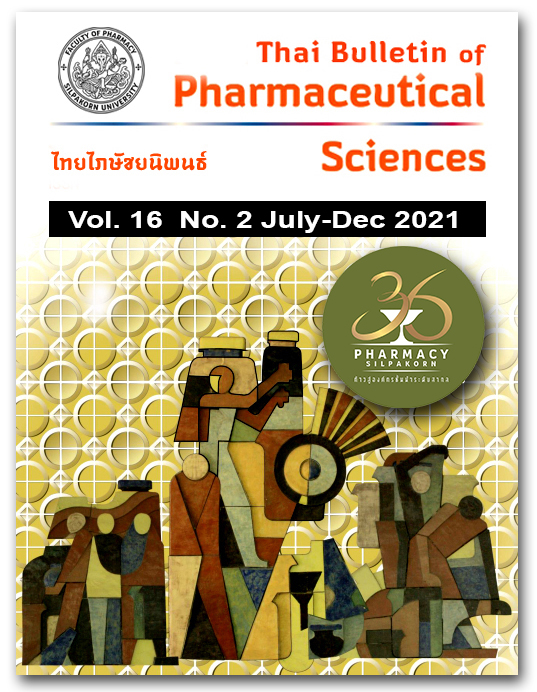CHENODEOXYCHOLIC ACID INHIBITS CFTR-MEDIATED CHLORIDE SECRETION IN RENAL TUBULAR CELLS
DOI:
https://doi.org/10.69598/tbps.16.2.11-18Keywords:
bile acid, chloride channel, fluid secretion, kidney, cyst progressionAbstract
Chenodeoxycholic acid (CDCA), a primary bile acid, has been reported to activate cystic fibrosis transmembrane conductance regulator (CFTR)-mediated Cl- secretion in intestinal cells. However, there have not been any reports on the role of bile acid in the regulation of CFTR-mediated Cl- secretion in renal cells. In this study, we revealed that CDCA reduced CFTR-mediated Cl- secretion in Madin-Darby canine kidney (MDCK) cells, renal tubular cells. Incubation MDCK cell monolayers with 20 µM CDCA for 48 h led to a decrease in [Arg8]-vasopressin (AVP)-induced Cl-current (ICl-). The inhibition on ICl- was not a result of CDCA-induced toxicity as shown by the treatment of the cells with CDCA for 72 h did not alter cell viability. Interestingly, acute incubation of MDCK cell monolayers with CDCA did not reduce ICl-. Furthermore, basolateral membrane permeabilization of MDCK cell monolayers still decreased apical ICl-, indicating that the target of CDCA might be located at the apical membrane. Western blot analysis revealed that inhibition of Cl- secretion occurred via a decrease in CFTR protein expression. These results reveal that CDCA inhibits Cl- secretion in renal tubular cells via a decrease in CFTR protein expression.
References
Gadsby DC, Vergani P, Csanády L. The ABC protein turned chloride channel whose failure causes cystic fibrosis. Nature. 2006;440(7083):477-83.
Morales MM, Falkenstein D, Lopes AG. The cystic fibrosis transmembrane regulator (CFTR) in the kidney. An Acad Bras Cienc. 2000;72(3):399-406.
Sun Y, Zhou H, Yang BX. Drug discovery for polycystic kidney disease. Acta Pharmacol Sin. 2011;32(6):805-16.
Souza-Menezes J, Morales MM. CFTR structure and function: is there a role in the kidney? Biophys Rev. 2009;1(1):3-12.
Briel M, Greger R, Kunzelmann K. Cl- transport by cystic fibrosis transmembrane conductance regulator (CFTR) contributes to the inhibition of epithelial Na+ channels (ENaCs) in Xenopus oocytes co-expressing CFTR and ENaC. J Physiol. 1998;508 (Pt 3):825-36.
Kunzelmann K. ENaC is inhibited by an increase in the intracellular Cl– concentration mediated through activation of Cl– channels. Pflügers Archiv. 2003;445(4):504-12.
McNicholas CM, Nason MW, Jr., Guggino WB, Schwiebert EM, Hebert SC, Giebisch G, et al. A functional CFTR-NBF1 is required for ROMK2-CFTR interaction. Am J Physiol. 1997;273(5):F843-8.
Ruknudin A, Schulze DH, Sullivan SK, Lederer WJ, Welling PA. Novel subunit composition of a renal epithelial KATPChannel. J Biol Chem. 1998;273(23):14165-71.
Davidow CJ, Maser RL, Rome LA, Calvet JP, Grantham JJ. The cystic fibrosis transmembrane conductance regulator mediates transepithelial fluid secretion by human autosomal dominant polycystic kidney disease epithelium in vitro. Kidney Int. 1996;50(1):208-18.
Hanaoka K, Devuyst O, Schwiebert EM, Wilson PD, Guggino WB. A role for CFTR in human autosomal dominant polycystic kidney disease. Am J Physiol. 1996;270(1 Pt 1):C389-99.
Wallace DP. Cyclic AMP-mediated cyst expansion. Biochimica et Biophysica Acta (BBA) - Molecular basis of disease. 2011;1812(10):1291-300.
Chang M-Y, Ong ACM. New treatments for autosomal dominant polycystic kidney disease. Br J Clin Pharmacol. 2013;76(4):524-35.
Verkman AS, Galietta LJ. Chloride channels as drug targets. Nat Rev Drug Discov. 2009;8(2):153-71.
Di Ciaula A, Garruti G, Lunardi Baccetto R, Molina-Molina E, Bonfrate L, Wang DQH, et al. Bile acid physiology. Annals of Hepatology. 2017;16:S4-S14.
Li T, Chiang JYL. Bile acid signaling in metabolic disease and drug therapy. Pharmacological Reviews. 2014;66(4):948.
Düfer M, Hörth K, Krippeit-Drews P, Drews G. The significance of the nuclear farnesoid X receptor (FXR) in β cell function. Islets. 2012;4(5):333-8.
Ding L, Yang L, Wang Z, Huang W. Bile acid nuclear receptor FXR and digestive system diseases. Acta Pharm Sin B. 2015;5(2):135-44.
Kawamata Y, Fujii R, Hosoya M, Harada M, Yoshida H, Miwa M, et al. A G protein-coupled receptor responsive to bile acids. J Biol Chem. 2003;278(11):9435-40.
Duan T, Cil O, Tse CM, Sarker R, Lin R, Donowitz M, et al. Inhibition of CFTR-mediated intestinal chloride secretion as potential therapy for bile acid diarrhea. Faseb j. 2019;33(10):10924-34.
Domingue JC, Ao M, Sarathy J, Rao MC. Chenodeoxycholic acid requires activation of EGFR, EPAC, and Ca2+ to stimulate CFTR-dependent Cl- secretion in human colonic T84 cells. Am J Physiol Cell Physiol. 2016;311(5):C777-c92.
Raksaseri P, Chatsudthipong V, Muanprasat C, Soodvilai S. Activation of liver X receptors reduces CFTR-mediated Cl- transport in kidney collecting duct cells. Am J Physiol Renal Physiol. 2013;305(4):F583-91.
Nofziger C, Brown KK, Smith CD, Harrington W, Murray D, Bisi J, et al. PPARγ agonists inhibit vasopressin-mediated anion transport in the MDCK-C7 cell line. Am J Physiol Renal Physiol. 2009;297(1):F55-F62.
Sullivan LP, Wallace DP, Grantham JJ. Chloride and fluid secretion in polycystic kidney disease. J Am Soc Nephrol. 1998;9(5):903-16.
Li H, Findlay IA, Sheppard DN. The relationship between cell proliferation, Cl- secretion, and renal cyst growth: A study using CFTR inhibitors. Kidney International. 2004;66(5):1926-38.
Makino I, Nakagawa S, Mashimo K. Conjugated and unconjugated serum bile acid levels in patients with hepatobiliary diseases. Gastroenterology. 1969;56(6):1033-9.
Keitel V, Cupisti K, Ullmer C, Knoefel WT, Kubitz R, Häussinger D. The membrane-bound bile acid receptor TGR5 is localized in the epithelium of human gallbladders. Hepatology. 2009;50(3):861-70.
Wang Y-D, Chen W-D, Moore DD, Huang W. FXR: a metabolic regulator and cell protector. Cell Research. 2008;18(11):1087-95.
Saint-Criq V, Gray MA. Role of CFTR in epithelial physiology. Cell Mol Life Sci. 2017;74(1):93-115.
Jouret F, Devuyst O. Targeting chloride transport in autosomal dominant polycystic kidney disease. Cellular Signalling. 2020;73:109703.
Downloads
Published
How to Cite
Issue
Section
License
All articles published and information contained in this journal such as text, graphics, logos and images is copyrighted by and proprietary to the Thai Bulletin of Pharmaceutical Sciences, and may not be reproduced in whole or in part by persons, organizations, or corporations other than the Thai Bulletin of Pharmaceutical Sciences and the authors without prior written permission.



